When the traveler curtain at the back of the stage opened during Ballet du Grand Théâtre de Genève’s performance of Faun in Festival 2024, revealing the opened barn doors of the Ted Shawn Theatre and the lush forest, audience members gasped in amazement. The dancers now stood amongst the trees, framed by the hazy sunset over the Berkshire hills and a crisp summer breeze wafting into the theater.
“Yesterday, watching Faun with the doors open, it was just magical,” Alexa Zanikos, Production Manager of the Ted Shawn Theatre, said. “Hearing the gasps inside when the traveler starts opening, it’s like, this is priceless.”
While artists present world-renowned dance works on the Pillow’s stages, another dance is happening behind the curtain – the Production Team at Jacob’s Pillow. Working behind the scenes, staff technicians bring together lighting and projections, audio and sound engineering, and the puzzle pieces of stage management to create life-long memories for artists and audiences. Production at the Pillow has its own obstacles unique to its history and setting, including unpredictable weather and working in nearly century-old buildings.
Zanikos, who has worked for production at the Pillow since her first role as an intern in 2015, said that the 92-year-old barn doors pose several challenges. This season, the world premiere of Figures in a Landscape by Wayne McGregor of The Royal Ballet featured dancers entering and exiting the stage through the opened barn doors – a stunning element which almost didn’t happen because of nature’s interference.
“We’re checking the weather through intermission,” Zanikos said. “It looks fine. There’s some storm passing above us, but it’s going to be fine… I open the door, and rain is coming down at a 30-degree angle.”
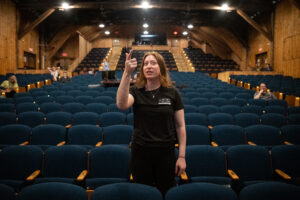
Key to working in production at Jacob’s Pillow is learning to adapt in situations like these, and being able to quickly readjust with the constantly shifting environment. Zanikos, armed with nearly a decade of institutional experience, relied on communication with her dedicated team to open the barn doors for a portion of the piece, ensuring that the vision of the work is maintained.
“That was one of the highest pressure situations I’ve ever experienced in my career,” Zanikos said.
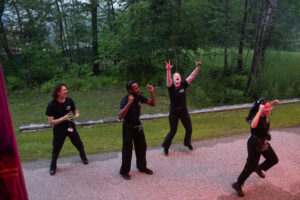
Isabella Tapia, Stage Manager of the outdoor Henry J. Leir Stage, said that while unpredictable weather and harsh conditions are a challenge for both artists and production staff on the Leir Stage, being out in nature brings something special to the pieces that can’t be achieved indoors.
“We’ve noticed that nature sometimes responds to the dances. Birds will show up at a certain point, the sun will hit during a beautiful moment in a piece. The wind will blow in a really nice moment,” Tapia said. “It’s really great to see those natural things that make it more theatrical.”

Outside of the complications of the natural world, communication and collaboration among internal staff and visiting artists and production teams can be both the greatest challenge and, if successful, the team’s greatest strength. With several one-night-only performances on the Leir Stage and a constant rotation of visiting artists, jumping right in with a sense of “welcoming” and “trust” is key: “We need to establish that trust quickly,” Tapia said.
Though visiting artists perform for a full week in the Ted Shawn Theatre, communication continues to be of paramount importance. Kat Denning, the Assistant Production Manager of the Ted Shawn Theatre who first came to the Pillow in 2023, said that working closely with a team with the right scaffolding for communication is what has led to successful productions in the theater this summer. Denning said, when solving an emergent situation backstage, they got to actively see “the bones that [they’ve] built” over the course of the summer come together.
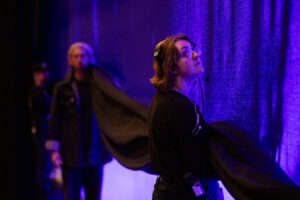
When the production team is able to truly collaborate with each other and the visiting artists and technicians, magic happens. Looking back on Gauthier Dance//Dance Company Theaterhaus Stuttgart’s performance of Ohad Naharin’s Minus 16 in Festival 2023, Denning remembers a moment when their efforts in production – a quick series of opening and closing the curtain at the end of the piece – became a dance in and of itself.
“The elements that I’m bringing to this, they’re actively involved in this art form,” Denning said. “The curtain is dancing with them as they’re doing their bows, and I’m right there, sweating with them.”
The Production Interns dive into the collaborative environment of the production team throughout their summer, rotating through different branches such as lighting and stage management to gain a breadth of experience. James Alexander, a Festival 2024 Production Intern, said that what they love most about their internship is the people.
“Not only getting to work with professionals, who are so welcoming and willing to learn and teach, but also the artist and company technicians as well,” Alexander said. “Everyone is willing to share their experiences and career tips that inspire and encourage.”
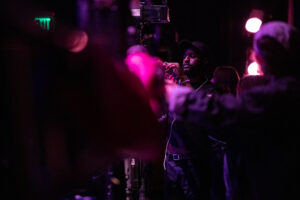
Aubria Battle, a stage operations technician, echoes this. A musician and artist alongside her production experience, Battle said that being working with the phenomenal artists and musicians of Camille A. Brown & Dancers for their world premiere of Brown’s I AM made “both of my worlds collide.”
“It really connects the dots for me as an artist because I get to experience and immerse myself in an environment of creativity and collaboration,” Battle said. “That’s what makes it special.”
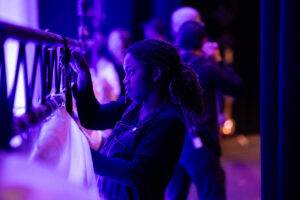
The collaborative energy felt between the artists and the production team extends to the entire theater, including the audience, said Zanikos:
“I’m just floored by the dancing, floored by the energy in the room. It’s so generative, and it’s so amazing… the Pillow is the place where we are cultivating welcoming. We are cultivating joy here.”
This Pillow Pick was written by Lucy Kudlinski and published on August 22, 2024.